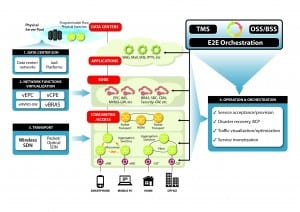Using SDN to offset the data capacity crunch
In 2014, operators are feeling the pressure from several quarters. Revenues from mobile and fixed line services are continuing to decline; traditional applications such as SMS are suffering erosion from innovative IP-based rivals; and the traffic across the network footprint is growing exponentially, with customers calling for higher performance and interconnectedness of experience.
September 29, 2014

In 2014, operators are feeling the pressure from several quarters. Revenues from mobile and fixed line services are continuing to decline; traditional applications such as SMS are suffering erosion from innovative IP-based rivals; and the traffic across the network footprint is growing exponentially, with customers calling for higher performance and interconnectedness of experience.
By the end of 2014, Informa’s WCIS+ forecasts almost 386 million LTE connections around the world. By the start of 2020, this number will have leapt to over 2.3 billion. This means 27 per cent of the predicted 8.4 billion mobile connections will be running on 4G technologies by 2020, with the balance largely on 3G.
In terms of data consumption, research predicts that monthly global mobile data traffic will surpass 15 exabytes by 2018; that’s 1.8GB per connection per month and more than half of that will be over LTE. Indeed, by 2020, equipment vendors have said they expect to be helping operators to deliver 1GB to every subscriber every day. The future, it would seem, is in mobile broadband.
Research published earlier this year suggests that SDN could help operators reduce operating expenses by as much as $9bn globally by 2017, with opex savings expected to be much greater than capex savings across five key network applications in every year until 2017.
Research conducted by analyst firm Strategy Analytics suggested that SDN could almost halve a perceived “backhaul shortfall” for operators and save them just under $5bn in capital expenses by 2017.
The research said that the value of opex savings will be seen across five key network applications: wifi offload/video redirect ($3.14bn); cloud RAN ($2.17bn); local breakout/internet IXP ($1.83bn); metro aggregation/load redistribution ($1.22bn) and small cells ($591m).
The Asia Pacific region is expected to save the most over this time period as operators in many markets in this region continue to migrate to all-IP networks. The region is expected to see opex savings of $5.62bn as a result of implementing SDN, followed by North America ($1.26bn) and Western Europe ($1.25bn).

Sdn Could Enable Operators To Create New Revenue Streams
Potential benefits include reduced operator CAPEX and OPEX; reduced time-to-market; improved return on investment from new services; greater flexibility to scale up, scale down or evolve services; openness to the virtual appliance market and pure software entrants; and opportunities to trial and deploy new services at lower risk.
As the three-tier hierarchy (access, aggregation, and core) of network architecture is being replaced by flatter architectures, virtualised application software is replacing network appliances, and network infrastructure is becoming more ‘programmable’. Ovum believes that SDN provides an opportunity to completely re-examine network architectures, introduce virtualisation, and provide truly innovative solutions, with more of a focus on the intelligence inherent in the network, rather than the feeds and speeds of data.
With SDN the network will dynamically adapt to provide the connectivity services that best serve the application and a better approach will eventually produce networks that are much more flexible in providing new services and monetising the network, as well as being more efficient in their use of resources.
It has also been claimed that SDN could enable operators to create new revenue streams, in a sector where operator margins from traditional services are being squeezed.
One basic use case is the notion of bandwidth on demand, that could include services such as “turbo boosts” that provision extra bandwidth for specific applications, based on the customer’s preferences.
A snapshot of NFV
Network Functions Virtualization (NFV) offers the path to evolution. At the highest level, it works by:Virtualizing the roles of the various network functions appliances into a series of Virtual Network Functions (VNF). These VNFs run on standardised servers, necessitating the virtualization of the physical network infrastructure to enable seamless deployment.VNFs are then linked together to provide a specific service for the customer, using service chaining architected, managed, repaired and monitored through open-source frameworks like OpenStack.
Service providers can now integrate this optimised virtual infrastructure with their existing or renewed orchestration system. This allows them to integrate their OSS/BSS implementation for dynamic rating, billing and delivering services in the blink of an eye.
The roles of industry bodies such as the Open Networking Foundation and the the OpenDaylight consortium are of increasing importance as global carrier networks seek to standardise systems. Companies like NEC have led the standardisation process through organisations like the ITU, 3GPP and the ONF and OpenDaylight projects as a way of meeting the needs to reduce operator CAPEX and OPEX. NEC is working with a variety of global partners to develop an application ecosystem and aims to create carrier-driven networks.
Furthermore, the NFV element which is added into the existing network needs advanced operational management in real time that differs significantly from the legacy system. NEC seeks to address the needs of Telecom Operations and Management Solutions (TOMS) that require these advanced schemes of operational management through its acquisition of NetCracker.
From billing, customer care, and real-time charging and policy solutions, to resource and network management, service fulfillment, and assurance, NetCracker’s software and services capabilities enhance the customer experience through content-rich offerings and reduced costs.
NEC has developed an orchestrator which extends beyond traditional TOMS and caters to the end-to-end orchestration required in SDN. Bear in mind that normally, when an operator implements SDN, they still have a legacy network, which requires the two systems to work closely together and the orchestrator plays a major role here, bringing services to market much quicker.
The benefits this can bring to telecoms service providers are profound, and can all be passed on to the customer. Replacing proprietary pieces of hardware with standardised servers and networking brings the agility to deliver new services dynamically while significantly reducing CAPEX and OPEX costs. This liberates the carriers from hardware lock-in which incurs extra costs further down the line; while being a boon to their customers fatigued from service providers being unable to adapt and deliver services that address changing business needs. The elevation of all the network functions to a single virtualized infrastructure with a common framework also means OPEX costs are likewise reduced, as operational visibility and management is simplified.
For the provider, the implementation process for a NFV solution is also considerably faster – especially if its customers are in the process of virtualizing their internal networks. As a result, new customers can be brought into the network faster, whilst existing customers can have their services upgraded quicker and with less complexity. Above all, NFV delivers new services that monetise the infrastructure.

SDN and NFV will be a key part of 5G developments.
In mid-May, Japanese carrier NTT Docomo farmed out contracts to several vendors in order to pilot 5G technologies, aiming for a 2020 launch of the technology.“5G studies are starting to gain real momentum as we point toward 2020.
We appreciate that 5G will provide significant performance enhancements to support future new applications that will impact both users and industry,” said Seizo Onoe, executive vice president and CTO at NTT Docomo, commenting on the pilot.Docomo is working on a 5G proof of concept system, using the 15GHz frequency band for the air interface as well as exploring the potential of millimeter wave technology in the 70GHz spectrum band.
With 5G standards so undefined at present there is a considerable focus on access network technologies mainly as an evolution to what has been seen in LTE and LTE-Advanced.
According to Dr Shahram G Niri, general manager of the 5GIC (5G Innovation Centre) at the University of Surrey in the UK, driving more data through the scarce, finite and expensive radio spectrum is the real challenge. “I therefore believe a new RAN becomes the main agenda for 5G,” he says.The 5GIC is one of several academic and vendor activities that have been announced as of this year.
The University of Surrey received funding from the UK government, major infrastructure vendors and mobile operators to establish the world’s first dedicated 5G programme and an international hub for telecommunication research and innovation with a unique, large scale 5G test bed.
As Niri points out, an evolution in radio access has normally defined the new generation and standard, from analogue 1G to digital 2G with TDMA, to 3G with WCDMA and finally 4G with OFDMA and SC-FDMA. Each standard also brought with it major attributes, such as 2G for mobility and roaming, 3G for multi-media service and 4G for full IP and greater spectral efficiency.
In this respect, Japanese carrier NTT Docomo is once again at the forefront, following up its 5G trial announcement with the successful virtualisation of the Evolved Packet Core (EPC) in joint verification tests with NEC, Alcatel-Lucent, and Cisco to support the functions required for Network Functions Virtualization (NFV).
The aim is to enable faster delivery of new telecom services and boost performance by applying virtualization technology to EPC software that takes on LTE data communication functions. The test results according to Docomo have confirmed EPC’s ability to adaptively boost processing capabilities through controls from the system that manages EPC in response to how much data customers use lending credence to the aforementioned concept of the reactive network.
Docomo checked the platform’s performance during a breakdown in hardware functions, when a backup structure was quickly and automatically constructed using different hardware in order to sustain stable data communications, effectively rerouting the connection.
 Get more information: http://www.nec.com/en/global/solutions/sdn/
Get more information: http://www.nec.com/en/global/solutions/sdn/
Read more about:
DiscussionAbout the Author
You May Also Like










.png?width=300&auto=webp&quality=80&disable=upscale)


_1.jpg?width=300&auto=webp&quality=80&disable=upscale)